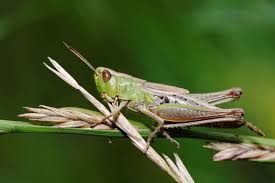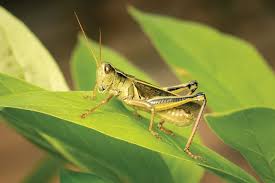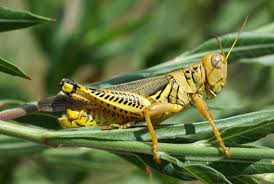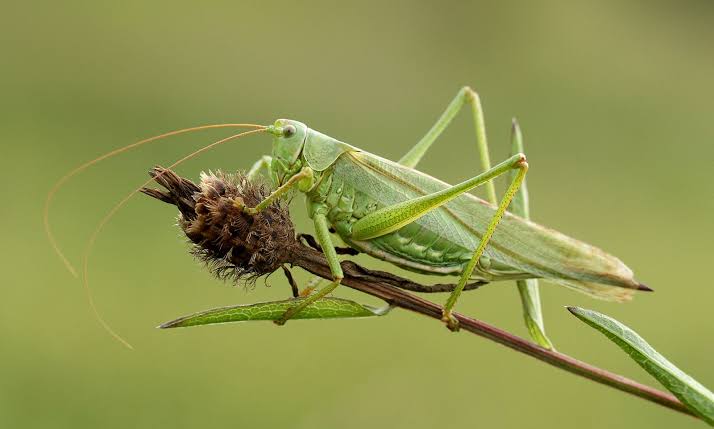Grasshoppers, which are scientifically known as Caelifera, are insects that hop and fly around. They have six legs and are part of the insect family. These creatures are often found in grassy areas, meadows, and fields. They come in various colors, like green, brown, and sometimes even a combination of both.
One interesting thing about grasshoppers is their strong hind legs. These legs help them jump great distances. They use their wings to fly, making them quite agile in their movements. You might see them hopping from one place to another or flying around, especially during warm and sunny days.
These insects are herbivores, which means they eat plants. Grasshoppers have chewing mouthparts that allow them to munch on leaves, grass, and other greenery. Some types of grasshoppers can be considered pests for farmers because they may eat crops, causing damage to the plants.
Grasshoppers go through different stages of life, starting as eggs laid in the soil. After some time, the eggs hatch into nymphs, which look like small grasshoppers but without wings. As they grow, they shed their outer covering in a process called molting. Eventually, they reach adulthood with fully developed wings.
They contribute to the balance of the ecosystem by being part of the food chain. Predators such as birds, reptiles, and certain mammals rely on grasshoppers as a food source. Additionally, these insects help regulate plant growth, showcasing their significance in maintaining the ecological harmony.
In some cultures, grasshoppers are seen as symbols of good luck or prosperity. People might even keep them as pets or study them to learn more about their behaviors.
Scientists find these insects fascinating due to their unique features and the important role they play in nature. In addition, grasshoppers are intriguing insects that hop and fly, with strong legs and a diet of plants. They go through various life stages, contributing to the ecosystem and sometimes causing challenges for farmers.
However, despite their small size, they hold a significant place in the natural world and can be appreciated for their interesting characteristics.
Plants Affected by Grasshoppers

Grasshoppers can affect a wide range of plants, including but not limited to:
1. Grains and Cereals: Crops like wheat, barley, oats, and corn.
2. Vegetables: Beans, peas, lettuce, carrots, and various garden vegetables.
3. Forage Crops: Alfalfa, clover, and other forage plants.
4. Fruits: Orchards with fruit-bearing trees and vines.
5. Grasses: Native grasses and turfgrasses in lawns and pastures.
Some of the damages that they cause on these plants include the following:
1. Defoliation: Grasshoppers consume leaves, leading to defoliation of plants. This affects the plants’ ability to photosynthesize and can reduce overall plant vigor.
2. Reduced Yield: The feeding activities of grasshoppers can result in reduced crop yields for grains, vegetables, and fruits, impacting agricultural productivity.
3. Stunted Growth: Young plants are particularly vulnerable, and grasshoppers can stunt their growth by feeding on tender shoots and leaves.
4. Crop Destruction: In severe infestations, they can cause complete destruction of crops, resulting in economic losses for farmers.
5. Transmission of Diseases: They can act as carriers of plant diseases, further compromising the health of affected crops.
Read Also: Sloes: History, Nutrition, Health Benefits and Growing Guide
Damages Caused by Grasshoppers (Caelifera)

Grasshoppers, while playing a role in the ecosystem, can sometimes cause damages, particularly in the context of agriculture. These insects are herbivores, meaning they feed on plants, and certain species can become pests for farmers.
The following are some of the notable damages that are caused by them:
1. Crop Consumption: They have a voracious appetite for plants, and when they occur in large numbers, they can consume significant amounts of crops. This includes grains, vegetables, and various types of vegetation that are important for human and animal consumption.
2. Reduced Crop Yields: The extensive feeding by grasshoppers can lead to reduced crop yields. As they devour plant material, crops may not reach their full potential, affecting the overall productivity of agricultural fields.
3. Economic Losses: Farmers may experience economic losses due to damaged crops. The cost of planting, cultivating, and maintaining crops can be compromised by grasshopper infestations, impacting the livelihoods of those dependent on agriculture.
4. Altered Ecosystem Balance: In some cases, if grasshopper populations are not naturally controlled, they can upset the balance of the ecosystem. Overgrazing by grasshoppers can lead to changes in plant communities, affecting other species that depend on these plants for food or habitat.
5. Increased Pest Management Costs: Farmers may need to invest in pest management strategies to control grasshopper populations. This can involve the use of pesticides, which, while addressing the grasshopper issue, may have environmental implications and additional costs for farmers.
It is important to note that not all grasshoppers cause significant damages, and their impact can vary depending on the species, environmental conditions, and the availability of alternative food sources. Balancing effective pest control with sustainable agricultural practices is crucial to managing the potential damages caused by them.
Read Also: Quinces: History, Nutrition, Health Benefits and Growing Guide
Control and Preventive Measures

Controlling and preventing grasshopper infestations in agricultural settings involves a combination of strategies aimed at managing their populations.
Here are some common control and preventive measures to follow:
1. Biological Control:
Introduce natural predators: Encourage the presence of natural predators such as birds, reptiles, and parasitic wasps, which feed on grasshoppers and help control their populations.
Beneficial insects: Release or attract beneficial insects like ladybugs and predatory beetles that prey on grasshopper eggs and nymphs.
2. Cultural Practices:
Crop rotation: Rotate crops to disrupt the life cycle of grasshoppers and reduce their ability to find suitable hosts.
Early planting: Plant crops early in the season to avoid coinciding with peak grasshopper activity, reducing the risk of infestation.
3. Mechanical Control:
Mowing and tillage: Regularly mow grassy areas and employ tillage practices to disturb the soil, exposing grasshopper eggs to unfavorable conditions and decreasing their survival rates.
Barrier crops: Plant crops that are less attractive to grasshoppers as a protective barrier around more susceptible crops.
4. Chemical Control:
Insecticides: Use insecticides as a last resort and apply them judiciously. Targeting nymphs when they are most vulnerable may be more effective than treating adult grasshoppers.
Biological insecticides: Consider using biological insecticides that are specific to grasshoppers and have minimal impact on non-target organisms.
5. Environmental Management:
Habitat modification: Modify the landscape to create less favorable conditions for them. This may include reducing tall grasses and providing barriers to limit their movement.
Moisture management: They thrive in dry conditions, so managing moisture levels in the soil can discourage their reproduction and survival.
6. Monitoring and Early Detection:
Regular scouting: Monitor fields and grassy areas regularly to detect grasshopper populations early. Early intervention is often more effective in controlling infestations.
7. Community Efforts:
Collaborative control: Encourage cooperation among farmers to implement coordinated grasshopper control measures over larger areas, making control efforts more effective.
It’s important to adopt an integrated pest management (IPM) approach, combining various strategies to minimize the reliance on chemical control and promote sustainable agricultural practices. Tailoring control measures to the specific conditions and species of grasshoppers in a given area enhances their effectiveness.
Read Also: 18 Medicinal Health Benefits Of Uncaria perrottetii (Sungay kalabaw)
Frequently Asked Questions (FAQs) About Grasshoppers
1. What is the lifespan of a grasshopper?
Their lifespans vary by species, but generally, they live for about 10 to 12 weeks as adults.
2. How do grasshoppers produce sound?
They produce sound by rubbing their hind legs against their wings, a behavior known as stridulation. This sound is used for communication, especially during mating rituals.
3. What do grasshoppers eat?
They are herbivores and primarily feed on a variety of plants, including grasses, leaves, and crops.
4. Do grasshoppers undergo metamorphosis?
Yes, they undergo incomplete metamorphosis. They have three stages in their life cycle: egg, nymph, and adult. Unlike complete metamorphosis, grasshoppers do not have a pupal stage.
5. Can grasshoppers fly?
Yes, they are capable fliers. Their hind legs are adapted for jumping, and they have functional wings that allow them to fly short to moderate distances.
6. How do grasshoppers defend themselves from predators?
They have various defense mechanisms. They can jump great distances to escape predators, and some species have coloration that helps them blend into their surroundings. Additionally, certain grasshoppers secrete substances that are toxic or distasteful.
7. What is the purpose of the antennae on a grasshopper?
The antennae of a grasshopper are sensory organs that help them detect environmental cues, including the presence of predators, mates, and suitable food sources.
8. How many eyes do grasshoppers have?
They typically have two large compound eyes that provide them with a wide field of vision.
9. Do grasshoppers migrate?
Yes, some of the species are known for their migratory behavior. They may travel in large swarms to find food or suitable breeding grounds.
10. Are grasshoppers harmful to crops?
While some of the species can be agricultural pests and cause damage to crops, not all of them are harmful. Integrated pest management strategies are often employed to control their populations when necessary.
Read Also: Physic-Chemical Treatment Process

